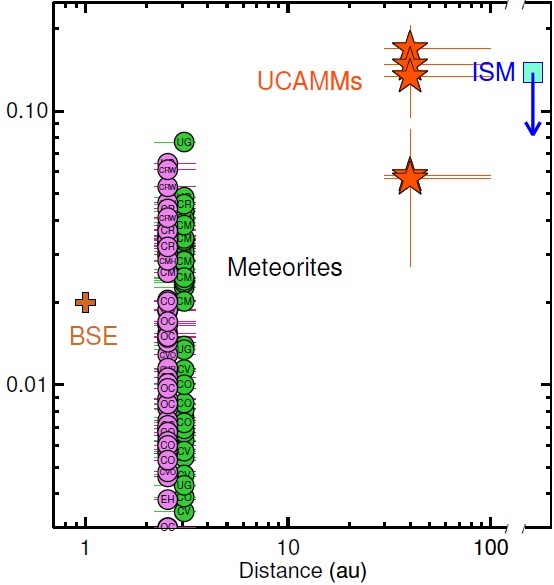- Details
- Published on 08 January 2018
Vol. 609
In section 10: Planets and planetary systems
Dome C ultracarbonaceous Antarctic micrometeorites: Infrared and Raman fingerprints
 Interplanetary dust particles travel across the solar system and represent the largest mass flux of extraterrestrial material falling on the Earth. Their small sizes (hundreds of microns or less) make their collection and analysis challenging. Dartois et al. analyze a small subset of these particles acquired from the Concordia/CSNSM micrometeorites collection performed in Antarctica, the so-called UltraCarbonaceous Antarctic MicroMeteorites (UCAMMs). These particles contain a large amount of nitrogen-rich organic matter not found elsewhere in extraterrestrial matter and probably originating from the outer solar system. The analyses show that both the C/Si and N/C abundance ratios in UCAMMs are the highest found in the solar system and are above the interstellar medium cosmic abundances. These finding are most important to understand the composition of outer solar system objects and the origin of primitive organics.
Interplanetary dust particles travel across the solar system and represent the largest mass flux of extraterrestrial material falling on the Earth. Their small sizes (hundreds of microns or less) make their collection and analysis challenging. Dartois et al. analyze a small subset of these particles acquired from the Concordia/CSNSM micrometeorites collection performed in Antarctica, the so-called UltraCarbonaceous Antarctic MicroMeteorites (UCAMMs). These particles contain a large amount of nitrogen-rich organic matter not found elsewhere in extraterrestrial matter and probably originating from the outer solar system. The analyses show that both the C/Si and N/C abundance ratios in UCAMMs are the highest found in the solar system and are above the interstellar medium cosmic abundances. These finding are most important to understand the composition of outer solar system objects and the origin of primitive organics.


